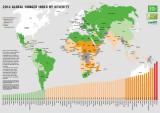Synopse Welthunger-Index 2014: Herausforderung verborgener Hunger
Der Welthunger-Index (WHI) 2014 stellt die nationale, regionale und weltweite Hungersituation zum neunten Mal in jahrlicher Folge multidimensional dar. Er zeigt, dass bei der globalen Hungerbekampfung seit 1990 Fortschritte erzielt werden konnten, jedoch angesichts sehr ernster oder gar gravierender Hungerwerte in 16 Landern noch immer groser Handlungsbedarf besteht.







